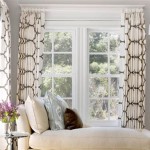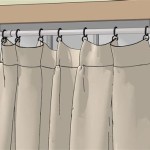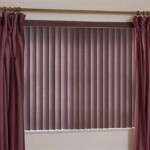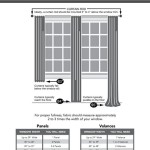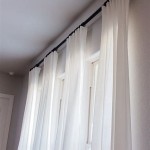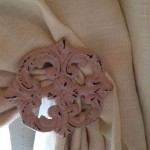Choosing the Right Curtains for 10-Foot Ceilings
High ceilings, particularly those reaching 10 feet, offer a sense of spaciousness and grandeur to a room. However, they also present unique challenges when it comes to window treatments. Selecting the appropriate curtains for these elevated heights requires careful consideration of several factors, including length, fabric, style, and hardware. The wrong choice can make a room feel disproportionate or lacking in visual appeal, while the right curtains can enhance the room's architecture and create a balanced, inviting atmosphere.
One of the primary concerns with 10-foot ceilings is achieving the correct proportions. Standard curtain lengths, typically designed for 8-foot ceilings, will appear inadequate and may even visually shorten the height of the room. The goal is to select curtains that either reach the floor gracefully or create a deliberate design statement that complements the ceiling height. This often necessitates custom-made curtains or the use of extra-long panels.
Beyond length, the fabric choice also significantly impacts the overall effect. Heavier fabrics tend to hang better and provide a more luxurious and substantial feel, which is often desirable in rooms with high ceilings. Lighter fabrics, on the other hand, can create a more airy and relaxed ambiance. The decision should align with the desired aesthetic and the functionality of the curtains, such as light control and privacy.
The style of the curtains should harmonize with the existing décor and architectural style of the room. Options range from classic pleated styles to modern grommet-top designs. The choice should reflect the overall design intent and complement the room's furnishings and color palette.
Finally, the hardware used to hang the curtains plays a crucial role in the overall presentation. The rod should be sturdy enough to support the weight of the curtains and should be positioned at an appropriate height to maximize the visual impact. Decorative finials and brackets can further enhance the aesthetic appeal.
Key Point 1: Determining the Appropriate Curtain Length
Accurately measuring for curtains is paramount to achieving the desired look in a room with 10-foot ceilings. The first step is to determine the ideal finished length of the curtains. There are three primary options: floor-length, pooling, and floating. Floor-length curtains gently touch the floor, creating a clean and tailored appearance. This is often the most popular choice for formal living rooms and dining rooms.
Pooling curtains, also known as "puddling," extend several inches onto the floor, creating a luxurious and dramatic effect. This style is best suited for rooms where the curtains are primarily decorative and won't be frequently opened and closed, as the excess fabric can collect dust and be cumbersome to manage. Pooling adds a touch of opulence and is well-suited for bedrooms or less frequently used living areas.
Floating curtains hang slightly above the floor, typically by about half an inch to one inch. This option is practical for high-traffic areas or where there are concerns about the curtains getting dirty or tangled. It also provides a cleaner, more modern look. This style is suitable for kitchens, bathrooms, or spaces where a more minimalist aesthetic is desired.
To accurately measure for curtains, first, install the curtain rod at the desired height. Generally, it's recommended to hang the rod 4-6 inches above the window frame, or even higher if the goal is to visually elongate the wall. Then, measure from the top of the rod (or the bottom of the rings, if using ring clips) to the desired finished length. This measurement will determine the required curtain length.
For example, if the rod is installed 6 inches above the window frame and the desired finished length is floor-length, the measurement should be taken from the top of the rod to the floor. If the measurement is 102 inches, then curtains with a finished length of 102 inches are needed. It is generally advisable to add a few extra inches to the length to allow for hemming or adjustments, especially when ordering custom-made curtains.
Key Point 2: Selecting the Right Fabric and Style
The fabric and style of the curtains significantly contribute to the overall aesthetic and functionality of the room. The choice of fabric should consider factors such as light control, privacy, insulation, and durability. The style should complement the existing décor and architecture, adding visual interest and enhancing the room's overall design.
For rooms requiring optimal light control and privacy, such as bedrooms or home theaters, heavier fabrics like velvet, blackout lining, or tightly woven linen are excellent choices. These fabrics effectively block out sunlight and provide a high degree of privacy. They also offer additional insulation, helping to regulate room temperature and reduce energy costs.
For rooms where a lighter and more airy feel is desired, such as living rooms or dining rooms, sheer or semi-sheer fabrics like voile, chiffon, or lightweight linen are suitable options. These fabrics allow natural light to filter through, creating a bright and inviting atmosphere. They also offer a degree of privacy while maintaining a connection to the outside world.
The style of the curtains should complement the room's architectural design. For formal spaces, pleated styles like pinch pleat, goblet pleat, or box pleat curtains are often preferred. These styles create a structured and tailored look, adding a touch of elegance and sophistication. They are well-suited for traditional or transitional décor.
For more casual or contemporary spaces, grommet-top, rod-pocket, or tab-top curtains are popular choices. These styles offer a more relaxed and informal look, making them suitable for modern or bohemian décor. Grommet-top curtains are particularly easy to install and operate, while rod-pocket curtains create a gathered and flowing appearance.
Consider patterns and colors that complement the room's existing color palette and furnishings. Solid-colored curtains can create a clean and understated look, while patterned curtains can add visual interest and personality. When choosing patterns, consider the size of the room and the scale of the pattern. Larger patterns can overwhelm smaller rooms, while smaller patterns may get lost in larger spaces.
Key Point 3: Choosing Appropriate Hardware and Installation Techniques
The hardware used to hang curtains is just as important as the curtains themselves. The rod should be sturdy enough to support the weight of the curtains and should be positioned at an appropriate height to maximize the visual impact. The brackets should be strong and securely mounted to the wall. Decorative finials can add a finishing touch and enhance the overall aesthetic.
For heavy curtains, it is essential to use a sturdy metal rod that can support the weight without sagging or bending. Consider using a rod with a larger diameter for added strength. The brackets should be securely mounted to the wall studs to ensure they can hold the weight of the rod and curtains. If studs are not available, use drywall anchors that are rated for the appropriate weight capacity.
The height at which the rod is installed can significantly impact the perceived height of the room. Hanging the rod higher than the window frame can create the illusion of taller ceilings and larger windows. Generally, it is recommended to hang the rod 4-6 inches above the window frame, but in rooms with 10-foot ceilings, consider hanging it even higher, perhaps 12 inches or more, to maximize the visual impact.
For rooms with particularly high ceilings, consider using extra-long extension brackets to extend the rod further away from the wall. This can help to prevent the curtains from blocking too much light and can create a more dramatic and visually appealing effect.
When installing the hardware, use a level to ensure that the rod is straight and even. This is particularly important for rooms with high ceilings, as any imperfections will be more noticeable. Use a stud finder to locate the wall studs and securely mount the brackets to the studs whenever possible.
Consider using decorative finials to add a finishing touch to the curtain rod. Finials can add a touch of elegance and sophistication to the room and can help to tie together the overall design. Choose finials that complement the style of the curtains and the room's décor.
Proper installation is crucial for ensuring that the curtains hang correctly and function properly. Take the time to carefully measure and install the hardware, and be sure to follow the manufacturer's instructions. With the right hardware and installation techniques, curtains can be a beautiful and functional addition to any room with 10-foot ceilings.
Ultimately, selecting and installing curtains for 10-foot ceilings involves a combination of careful planning, precise measurements, and an understanding of design principles. By considering the length, fabric, style, and hardware, one can create a window treatment that enhances the beauty and functionality of the space, truly capitalizing on the grandeur that high ceilings afford.

Extra Long Sheer Voile Curtains 2 Panels For High Ceiling 10 Etsy

Ombre Sheer Curtains Drapes Extra Long 10 20 Ft Ikiriska

100 Blackout Extra Long Linen Curtains Custom Made 9 24 Feet Length Wide 2 Story Living Room Ikiriska Off White Gray Tall Ceiling Drapes Etsy
Where Do You Hang Curtains On A 10 Foot Ceiling Quora

Ombre Sheer Curtains Drapes Extra Long 10 20 Ft Ikiriska

Extra Long Natural Linen Curtains Drapes Custom Made 10 12 13 Etsy Living Room

Ak Trading Co 120 Wide 10ft Sheer Voile Drape Panels For Backdrop Wedding Events Ceiling Drapes Event Masking Decor Select From 6ft To 50ft Length 10 Feet X 30

Ak Trading Co 120 Wide 10ft Sheer Voile Drape Panels For Backdrop Wedding Events Ceiling Drapes Event Masking Decor Select From 6ft To 50ft Length 10 Feet X 30

1 Panel 10 X 40 Ft Premium Sheer Voile Ceiling Curtains Drapes

Scalamandre Vivaldi 10 Foot Ceilings Curtains The Glam Pad


